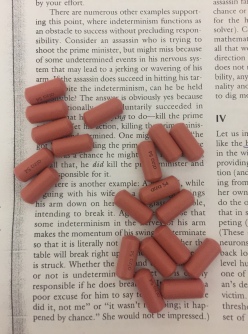By: Hunter Nestadt
It is 10pm, three days before this article is due and I have just taken a 36mg dose of Concerta. For me this is normal. Since being prescribed Concerta at the age of 12, it has become my go to substance for times when I had let my tendency to procrastinate get the better of me, and I was left with less than 72 hours to submit 5000 words worth of work. Before arriving at Rhodes University I was totally unaware of the fact that I was not the only one who did this, and even more astonishingly I found out that people used Concerta as a party drug. It confused me that something I had seen purely as a medication was being anything other than that. So I began to investigate.

Concerta, like Ritalin is a drug made from Methylphenidate and is most commonly used to treat Attention Deficit Disorder (ADD) and Attention Deficit Hyperactivity Disorder (ADHD). It works by increasing the effects of the neurotransmitters dopamine and norepinephrine, both of which contribute one’s ability to stay alert, remain focussed and control impulses.
Combined with the fact that one of the side effects of Concerta is an inability to sleep, it becomes clear why a drug like this would be sought after in academic environments, where there is a demanding workload and students are expected to maintain a high standard of work.
Stimulants like Concerta are classified as schedule six drugs because they are considered to be highly addictive and have potentially harmful side effects. This means that to legally obtain Concerta one must have a prescription from a doctor, and the drug must be dispensed on a month to month basis.
In an interview I conducted with a source that opted to remain anonymous, I was told that she only took the drug “when circumstances are dire” and she receives Concerta for free from friends in her residence. She also stated that despite experiencing some negative side effects, such as headaches, nausea and heart palpitations she had no idea that there are any negative effects of using Concerta.
This speaks to the fact that there is a danger in the having a population of unmonitored Concerta users, because these people are not being properly advised on how to use the drug correctly by medical professionals.

Another interviewee said that they had never used stimulants like Concerta and Ritalin for academic purposes, but before a night out he would crush a Ritalin tablet and snort it because he felt it made it easier to socialise because he felt “sharper and more on-the-ball” in conversation, and helped him remain awake through the night making it “an ideal party drug”.
Research has concluded that the mixing of alcohol and Ritalin increases the chance of the user experiencing the side effects as alcohol causes methylphenidate (the active ingredient in both Ritalin and Concerta) to be released into the blood at a faster rate which means that although it may be effective it is not a safe party drug when used in conjunction with alcohol.
The final interview I conducted highlighted the fact that there are some legitmate cases where Concerta is used but not abused. “I have a prescription for Concerta, but I don’t always fill it” said an anonymous source “I only take it when I’ve dug my own grave, but I am fully able to get work done without it”. She also said that the process that she went through to get find her perfect dosage was carefully monitored by a well-informed doctor.
Through research I have discovered that the culture of Concerta/ Ritalin use in universities makes sense as it these drugs play the role of both academic and social enhancers which are both key features of university life. It is also obvious that there is a high rate of students abusing these drugs which could be put down to misinformation and misunderstanding of how these substances work.
If you would like to read more about this topic, follow these links:
https://www.cbsnews.com/news/kiddie-cocaine-behavior-drug-ritalin-abused-by-children/
https://www.thedailyvox.co.za/ritalin-abuse-university-students-voxes/